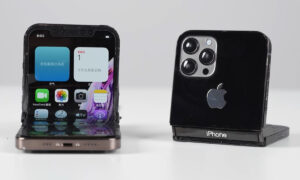Apple’s MacBook Air and 13-inch MacBook Pro released in 2020 will be equipped with self-developed M1 chips for the first time, greatly improving device performance and causing a heavy blow to Intel’s CPU business. Less than a year later, Apple began to compete with AMD and Nvidia products in the GPU field.
The display effect of the new MacBook Pro equipped with M1 Pro and M1 Max chips is even comparable to that of Windows laptops equipped with discrete graphics. It demonstrated for the first time the outstanding performance of Apple’s M1 series chips in display performance, which also gave Nvidia and AMD’s graphics business.
Moreover, Nvidia has been trying to attract Apple’s professional design and creative development customers through dedicated workstations. But in the recently released MacBook Pro, Apple not only managed to solve the device interface and keyboard touch bar problems that have been criticized by users but also used the M1 series of chips to meet user expectations for performance. This result excites professional designers.
In the past five years, Windows laptops have become more and more attractive to Mac users, but Apple’s M1 Pro and M1 Max chips have broken this situation, especially in the GPU field. The business with AMD and Nvidia seems there has been competition. Apple is confident to provide users with the same performance as top discrete graphics cards through the M1 series of chips while reducing power consumption. This is also part of Apple’s plan to completely transition the Mac product line to use Apple Silicon chips by the end of 2022.
Stay tuned with us via Telegram
Last week, Apple compared the MacBook Pro equipped with the M1 Max chip with two high-end Windows laptops, claiming that the M1 Max can reduce power consumption by 100W and display performance close to or even higher than Nvidia’s GeForce RTX 3080 chip. Although M1 Max may be the most powerful chip in Apple’s history, compared with the RTX 3080 discrete graphics card, M1 Max still integrates graphics and image processing functions on the processor chip.
A third-party evaluation found that Apple’s M1 Pro and M1 Max chips performed well in productivity-focused loads, and GFXBench scores were even close to laptops equipped with Intel Core i9-11980HK processors and GeForce RTX 3080 discrete graphics.
Furthermore, when running Adobe Premiere Pro, M1 Max is only slightly slower than GeForce RTX 3080, and the performance of M1 Max depends on the specific work. In the test, it takes 10 minutes and 17 seconds to complete the rendering with Adobe Premiere Pro, while it only takes 4 minutes and 16 seconds to complete the rendering with Apple’s Final Cut Pro software.
The real shortcoming of M1 Max and M1 Pro lies in the game. When running the game “Tomb Raider: Shadow”, the performance of M1 Max is only equivalent to the performance of the GeForce RTX 3060 graphics card. The test also showed that the flagship M1 Max MacBook Pro in Borderlands 3 is less than half of the performance of laptops equipped with RTX 3080.
Considering that the bottom layer of most macOS cross-platform games is still the X86 architecture, and macOS has never been a real game platform, it is not surprising that M1 Max does not perform well in games.
 According to related evaluations, “It is obvious that Apple’s experience in GPU has paid off with the development of A-series chips and M1 series chips.” “In short, the new M1 series chips prove that Apple can build powerful GPUs for its own high-end machines. AMD and Nvidia are no longer needed.”
According to related evaluations, “It is obvious that Apple’s experience in GPU has paid off with the development of A-series chips and M1 series chips.” “In short, the new M1 series chips prove that Apple can build powerful GPUs for its own high-end machines. AMD and Nvidia are no longer needed.”
Besides, Apple is also developing larger chips. It is reported that Apple has designed two-chip variants for the next generation of Mac Pro desktop computers, “The number of CPU and GPU cores are respectively 2 times and 4 times that of M1 Max.” This will make Mac Pro high-end models built-in up to 40 CPU cores and 128 GPU cores.
AMD currently provides Radeon Pro discrete graphics cards for Apple Mac Pro. If the number and performance of GPU cores in Apple chips continue to increase, then Apple’s own chips can easily exceed AMD’s Radeon Pro W6000X graphics cards. The premise is that Apple chip designers pay less attention to mobility and pay more attention to how to cool the hardware for maximum performance.
If more software and games are optimized for the M1 series of chips, coupled with Apple’s continuous improvement of the chip, then Apple may redefine user expectations for its own desktops, just like it redefines expectations for laptops at the end of last year.















